30-Year Dental/Migraine Connection
Approximately 45 million Americans suffer from chronic headaches, and of them, 28 million suffer from migraines. To the chronic migraine headache sufferer, headaches can mean more than sheer physical torture –they can disrupt work, destroy weekend plans, and even put a strain on marriage and relationships with family and friends. Statistically more woman get migraines than men. Twenty-five percent of women and 8% of men get migraines sometime in their lifetime.
Contrary to popular belief, only 60% of migraines are one-sided. Fifteen percent of people with migraine always get migraine on the same side. Eighty percent of migraineurs deal with nausea, but only 30% actually throw up. Eighty percent are sensitive to light and noise, most often light. Forty-five percent have autonomic symptoms, which include congestion or redness of the eye. Ten percent get prodromal symptoms warning of an onset of migraine.
There are many migraine triggers: foods, physical exertion, hormonal imbalances, psychological distress, environmental factors and drugs. These represent the most common ones, however, other factors exist which are often not factored into the examination equation because of a lack of common knowledge. These areas focus on dental issues and often involve multiple underlying causes. One such case recently treated was a 53-year-old Caucasian woman who suffered severe migraine headaches for 30 years. Despite numerous attempts by well-trained medical specialists, A.G’s headaches persisted.
A.G’s symptom picture included 24 to 36 hours of migraine pain during her menstrual cycle accompanied by a six-hour period of nausea. Her migraines worsened over the last 10 years, averaging at least one each month and more frequent episodes during the summer months. With the migraines came an increase in depression, anxiety and lethargy. There was no relief from any of the physician prescribed drugs. A.G. even underwent “sinus” surgery hoping it would remove a precipitating factor, but to no avail. Even homeopathic remedies prescribed by a trained homeopath were tried with no relief.
The dental component to illness is often over looked because most physicians and many dentists are unaware of the impact the structural and toxic effects dental materials have on the body. A deep over bite, which A.G. presented, causes compression of the spine, especially at the base of the skull. Anatomically all the vertebrae of the spine have a three point contact with the exception of the atlas, the first cervical vertebrae. The third point that stabilizes the atlas is the occlusion or the coupling of teeth. This is the reason why patients with malocclusions, invariably do not hold their osteopathic or chiropractic adjustments. Malocclusions also will cause distortions of the skull bones creating torsions or twist patterns in the membrane system within the skull. The membranes are innervated with sensory nerves from each branch of the trigeminal or fifth cranial nerve. Stretching or tension will illicit pain. The twisting or torsion of the skull/membrane complex explains why half the head is in pain. Changes in structural misalignment are the reason why the pain patterns can shift.
Also it is scientifically known that mercury fillings leak vapor during chewing and consumption of hot beverages. It has been scientifically documented that droplets of mercury are given off 24/7 and leak into the body. This continuous stream of the second most toxic substance on this planet passes through the lymphatic system, which drains the oral structures and into the thyroid, liver, heart, lungs and brain. Furthermore mercury has an affinity for nerve tissue and migrates along the nerves destroying the tubulin, which makes up the fatty layer of the nerve. Mercury exposure also comes from eating contaminated fish (specially tuna and swordfish) and breathing polluted air. The coal used to fuel power plants has mercury, which then enters the atmosphere and precipitates back into streams and farmland from rainfall. Once in the system, mercury can mimic any medical illness.
An additional factor in A.G’s. case was her work environment. She works as a landscape architect, which exposes her to potentially toxic chemicals in the form of pesticides, herbicides and fungicides. Once breathed in or entrance through the skin, these substances are carried via the lymphatic system into the thyroid, liver and other organs. In addition A.G. had both chemicals and mercury in her thyroid, both substances have the ability to suppress gland activity.
Since A.G.’s migraines always appeared just prior to the onset of her menstrual cycle, it was obvious that a hormone imbalance provided another overlaying factor. The key components that interplayed in her 30-year bout with severe migraines focused on four major factors:
- Collapsed dental bite (deep overbite)
- Chemical toxicity in the thyroid (mercury and pesticides)
- Hormone imbalance
- Poor orthodontics as a child, which never resolved the deep overbite problem
Treatment focused on removing the four major factors over a nine-month period. Since supporting the deep overbite, chelating out the mercury and chemicals and nutritional support to balance nutritional deficiencies, A.G. has not had a migraine headache in four months. In addition, she has less sinus problems, more energy and enthusiasm, and less anxiety and depression. Last results can only be achieved by removing the causative factors.

A lower orthopedic appliance was fabricated to provide posterior vertical support. By restoring the lost height, the facial, jaw and neck muscles are supported. In addition, restoring the vertical height functions to traction the upper cervical vertebrae and stabilize the atlas.
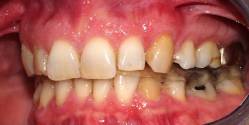
Lower left posterior view. Appliances cannot be made to an arbitrary vertical height. A physiological position is achieved by having the patient swallow into soft wax pads, which change to the muscle tension created during the swallowing process. After ten to fifteen minutes the muscles establish a 3-dimensional jaw position that is comfortable for the patient. A dentist by the name of Willie May from Albuquerque New Mexico developed this technique in the 1960’s.
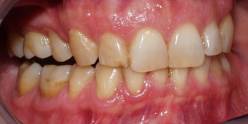
Lower right posterior space showing the amount of support needed to stabilize the bite, neck and muscles.
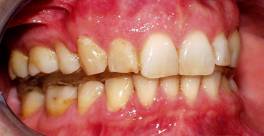
Lower right posterior view of the orthopedic appliance. To achieve maximum results appliances must also be adjusted to correct occlusal cranial discrepancies. Since the bite represents the self-correcting mechanism for balancing the skull bones the appliance has to provide proper contact to stabilize the skull and spine.
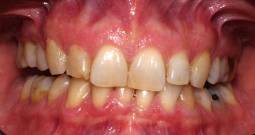
When the appliance is removed, the relaxed muscles reposition the lower jaw, which exhibits a space. This area provides a guide for the final treatment stage, which requires orthodontics or braces to erupt the posterior teeth to establish contact.
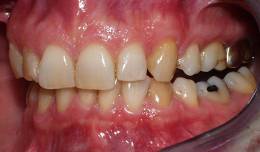
Lower left posterior space showing the amount of support needed to stabilize the bite, neck and muscles.
Treatment focused on removing the four major factors … supporting the deep overbite, chelating out the mercury and chemicals and nutritional support to balance nutritional deficiencies …
FREE PRESENTATION
Download the slides from Dr. Smith's presentation on the Dental Whole Body Connection in Ontario on October 25, 2024.
A comprehensive seminar to awaken you to the potential dangers of dental treatments.

STAY INFORMED
Big tech and mainstream media try to suppress the powerful information I have to share. Subscribe here to stay informed!
